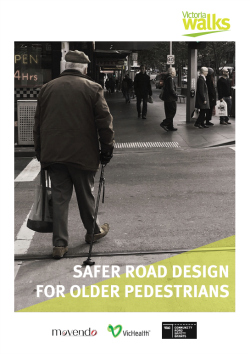Safer Road Design for Older Pedestrians
This research identifies ways for road managers to provide safer street environments for older pedestrians – people 65 years or older. The report encompasses:
- A review of the current literature on the importance of walking for older adults, the factors impacting safety for older pedestrians and the changes in capability associated with ageing
- A review of 1,149 older pedestrian crashes recorded in the VicRoads CrashStats database in the five year period between 1 July 2008 and 30 June 2013.
- Recommendations to make the road environment safer for older pedestrians to walk.
Key findings from the report include:
- Older pedestrians experience an average of 17 fatalities, 147 serious injuries and 114 other injuries in Victoria each year, with an estimated economic cost of $110 million per annum (in 2012 dollar values).
- People aged 65 and over represent 14.6% of the population yet account for 39% of pedestrian fatalities.
- People 85 years of age or older represent only 2% of the population in Victoria (and 3.3% of pedestrian crashes), but are 13% of pedestrian deaths.
- The most common crash scenario for older pedestrians is being hit by a motorist turning right as they exit an intersection – 18% of all crashes.
- At unsignalised intersections, motorists should have given way in at least 42% of crashes involving older pedestrians. At signalised intersections, motorists were required to give way in at least 72% of crashes.
- Vehicles colliding with pedestrians on footpaths, footpath driveways or at entrances to car parks, comprise at least 16% of all older pedestrian crashes, and 23% for those 85 and older.
Having considered the evidence from around the World and the Victorian crash statistics, the report recommends various infrastructure treatments to provide safer streets for older pedestrians, including:
- Safer design standards for driveways to indicate priority for pedestrians and provide physical cues for drivers.
- Raised pedestrian crossings at intersections and roundabouts to reduce vehicle speeds at the crossing point, enhance priority for pedestrians and make them more conspicuous to drivers.
- Raised thresholds, which effectively extend the footpath across an intersection, to emphasise that drivers are required to give way when turning.
- Kerb extensions, median refuges and tighter turn radii at intersections and roundabouts to reduce vehicle speeds, distance of pedestrian exposure and complexity of crossings.
- Fully controlled right turn signal phases.
- Reduced speed limits and area wide traffic calming.
The report was prepared by transport consultants movendo (lead author Jose Mantilla) and Victoria Walks (Duane Burtt), in collaboration with the Municipal Association of Victoria (MAV). Funding was provided by a Community Road Safety Grant from the Transport Accident Commission (TAC), along with VicHealth’s ongoing support of Victoria Walks.
